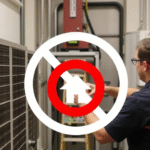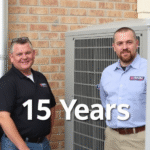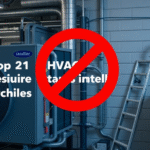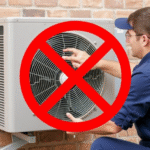Analysis of the Recent Surge in HVAC Services M&A Deals within the Refrigeration Sector
The HVAC services market is witnessing a remarkable transformation, particularly in the refrigeration sector. Recent data indicates a significant surge in mergers and acquisitions (M&A) deals, revealing a dynamic landscape that’s reshaping the industry. This surge not only highlights the growing importance of refrigeration services but also illustrates a strategic pivot among businesses aiming to stay competitive in the evolving market.
Key Drivers of the Surge in M&A Deals
Several factors contribute to this notable increase in M&A activities:
- Technological Advancements: Rapid advancements in refrigeration technology, including energy-efficient systems and smart controls, are enticing companies to merge, enabling them to enhance their service offerings.
- Increased Demand: The rise in demand for refrigerated storage and transportation spurred by e-commerce growth during the pandemic has made this sector particularly attractive.
- Regulatory Changes: Stricter environmental regulations are pushing companies to collaborate, combining resources to meet compliance standards more efficiently.
- Market Consolidation: Industry leaders are keen on acquisitions to consolidate their market position, streamline operations, and reduce competition.
Recent M&A Trends
The following is an overview of the recent trends observed in HVAC services M&A deals:
| Year | Number of Deals | Estimated Value ($ billion) |
|---|---|---|
| 2022 | 50 | 1.5 |
| 2023 | 85 | 3.2 |
This data underscores a marked increase in both the number of deals and the capital involved, signifying a robust interest in the refrigeration sector.
Implications of Recent M&A Activities
The uptick in M&A deals within HVAC services has several implications for the industry:
- Enhanced Capabilities: Mergers often lead to an enhancement of capabilities. By combining resources, companies can offer better services and innovate more effectively.
- Strengthening of Market Position: Businesses that engage in strategic acquisitions may experience a strengthened position in the market, making it harder for smaller players to compete.
- Job Creation and Redundancies: While some jobs may be created due to expansion, mergers can also result in redundancies. It’s essential for companies to manage their workforce strategically during transitions.
Financial Outlook
The financial outlook for HVAC services in the refrigeration sector remains optimistic. Analysts project that continued M&A activity will lead to larger, more efficient companies that can better serve market needs. As a result, businesses may experience:
- Increased Revenue: Merged companies often report increased revenues due to expanded service offerings and client bases.
- Cost Efficiency: M&A often results in cost savings through economies of scale, allowing companies to operate more efficiently.
- Investment Opportunities: New entities formed through mergers are likely to attract investors seeking stability and growth potential in the refrigeration space.
The surge in HVAC services M&A deals within the refrigeration sector is intricately linked to technological advancements, increased demand, regulatory changes, and market consolidation. Businesses operating in this space should stay informed on these trends, as they present both opportunities and challenges. Those who leverage strategic partnerships effectively will likely see innovative growth and improved service delivery.
For further insights and data about the HVAC services market, you may explore resources such as The News and Green Builder Media.
Key Drivers Behind Increased Mergers and Acquisitions in the Refrigeration Industry
The refrigeration industry is experiencing a remarkable surge in mergers and acquisitions (M&A), driven by several key factors. Understanding these drivers can provide essential insights into this dynamic market landscape.
Growing Demand for Energy Efficiency
As environmental consciousness increases, so does the pressure on companies to adopt energy-efficient solutions. Businesses and consumers are more aware of their carbon footprints, pushing manufacturers to develop advanced refrigeration technologies. In response, many firms are opting to merge with or acquire companies that specialize in energy-efficient systems. This allows them to enhance their offerings quickly while improving sustainability.
Technological Advancements
The rapid pace of technological innovation is reshaping the refrigeration sector. New technologies, such as smart cooling systems and IoT integration, are becoming standard. Companies are seeking to merge with or acquire tech-centric refrigeration firms to stay competitive and to leverage these advancements. Through these strategic moves, they can broaden their product portfolios and provide innovative solutions to their customers.
Regulatory Compliance
With the introduction of stricter regulations regarding refrigerants and environmental impact, many organizations find themselves needing to adapt quickly to remain compliant. Merging with or acquiring companies experienced in regulatory matters enhances operational efficiency and compliance capabilities.
Market Consolidation
The refrigeration market is witnessing increased consolidation as companies strive to expand their market share. By acquiring smaller firms or merging with other key players, organizations can effectively command a larger slice of the market, allowing for greater economies of scale and brand recognition.
Strategic Diversification
As businesses look to mitigate risks and expand their service lines, diversification has become a prevalent strategy. Companies are acquiring specialized refrigeration firms to enhance their overall offerings. This enables them to cater to various sectors such as commercial, residential, and industrial refrigeration.
Enhanced Customer Experience
A growing expectation for seamless and enhanced customer experiences is driving M&A activity in the refrigeration industry. Companies are focusing on merging with service providers that offer superior customer interaction and innovative service solutions. This ensures that they can provide a comprehensive service model, including installation, maintenance, and technical support, which is vital for customer retention.
Impact of Globalization
Globalization is another pivotal factor influencing M&A in the refrigeration sector. Companies are keen to tap into emerging markets with high growth potential. By acquiring local firms situated in these regions, organizations can develop a more robust global footprint, improving their logistics and distribution capabilities.
Refrigeration Sector M&A Statistics
| Year | Number of Deals | Combined Value (Billion USD) |
|---|---|---|
| 2021 | 15 | 3.5 |
| 2022 | 25 | 5.2 |
| 2023 | 40 | 7.8 |
Increased Investment in Cold Chain Logistics
As e-commerce continues to grow, so does the need for efficient cold chain logistics. In recent years, companies have recognized the importance of maintaining the integrity of products requiring refrigeration from supplier to end-user. This realization has fueled M&A activity as firms seek to expand their cold storage capabilities through strategic acquisitions.
Market Trends and Consumer Preferences
Changing consumer preferences also play a critical role. As customers increasingly demand fresh and frozen foods with fewer preservatives, there’s been an uptick in refrigerated warehousing. Companies looking to meet these consumer trends are merging or acquiring to enhance their supply chain capabilities and ensure they can meet the growing demand.
The surge in M&A activity in the refrigeration sector is a multifaceted phenomenon driven by various economic, technological, and consumer factors. Companies that actively engage in this landscape are well-positioned to thrive and adapt to the changing market, ensuring they meet the evolving needs of their customers. For more detailed insights into HVAC services and M&A trends, you can visit HVAC.com and Mergermarket.
Impact of HVAC Services M&A on Small and Medium-Sized Refrigeration Companies
The HVAC services market has seen an exciting shift in recent years, particularly in the area of mergers and acquisitions (M&A). This surge in M&A activity is significantly impacting small and medium-sized refrigeration companies, driving both challenges and opportunities. Understanding these effects can help business owners navigate the evolving landscape while positioning themselves for success.
As larger HVAC companies acquire smaller refrigeration firms, they often do so to expand their market reach, diversify service offerings, or enhance expertise in specialized areas. This phenomenon can lead to several significant changes in the industry:
- Increased Competition: With larger players entering the market, smaller refrigeration companies may find it more challenging to compete. These larger companies often have access to greater resources, advanced technology, and extensive customer bases.
- Investment Opportunities: The M&A surge can lead to increased investment in the refrigeration sector. Smaller companies may benefit from improved capital investment, marketing support, and access to advanced technologies that arise from being part of a larger organization.
- Focused Specialization: In the wake of consolidation, some small firms may decide to carve out niche markets or specialize further in areas such as energy-efficient installations, eco-friendly refrigerants, or temperature-sensitive logistics, enhancing their competitive edge.
It’s important to note how these changes can also lead to financial growth for smaller companies. Participating in the M&A wave can offer several financial benefits, including:
- Valuation Growth: As the perceived value of HVAC services rises due to increased demand, smaller companies may experience a boost in their market valuation. Selling at the right time can yield significant returns for business owners contemplating retirement or seeking to cash out.
- Access to Best Practices: Being part of a larger organization can expose smaller firms to robust operational practices, better customer service strategies, and improved supply chain management, making them more efficient and competitive.
However, the impact of HVAC services M&A on small and medium-sized refrigeration companies is not solely positive. Several challenges can stem from these acquisitions:
- Job Security Concerns: Employees in smaller refrigeration businesses may feel uncertain about their job security after an acquisition, leading to potential talent retention issues.
- Loss of Identity: Mergers often lead to the dilution of company culture. Small firms that pride themselves on personalized service may struggle to maintain their unique identity within a larger entity.
Despite the obstacles, there are ways for small and medium-sized refrigeration companies to leverage the M&A trend positively. Here are some strategies to consider:
- Diversifying Services: Expanding service offerings, including maintenance contracts and emergency repair services, can make smaller firms more attractive to potential buyers.
- Building Strategic Partnerships: Forming alliances with other companies can enhance service capabilities and broaden market reach. Such collaborations may also attract the attention of larger firms interested in M&A.
- Investing in Technology: Keeping up with technological advancements ensures smaller firms remain competitive. This preparedness can increase their desirability in potential M&A scenarios.
Several resources can help small refrigeration companies navigate this evolving landscape:
| Resource | Description | Link |
|---|---|---|
| HVACR Business | A comprehensive portal offering news, insights, and business resources for HVAC professionals. | HVACR Business |
| ACHR News | Provides news and updates on HVAC industry trends, including M&A activity. | ACHR News |
| Contracting Business | Offers industry analysis, including expert opinions on M&A trends and business strategies. | Contracting Business |
While the impact of HVAC services M&A on small and medium-sized refrigeration companies can present both risks and rewards, those who adapt to changes will likely find new opportunities for growth. Understanding the environment and implementing strategic actions can help businesses thrive, even amidst the complexities of the market.
Future Trends in the Refrigeration Sector Following Recent M&A Activities
The refrigeration sector is experiencing a transformative period, particularly following a significant rise in mergers and acquisitions (M&A) activity. As companies strategically realign themselves, there are emerging trends worth noting for anyone involved in or observing the industry closely.
One key trend is the growing focus on energy efficiency. With regulatory pressures mounting globally, companies are investing in advanced technologies that reduce energy consumption. This is not just about compliance; it’s about staying competitive. Enhanced energy-efficient systems can lead to substantial savings and long-term viability in a market increasingly focused on sustainability.
Many companies are looking to integrate cutting-edge refrigeration technologies that offer reduced environmental impact. Options such as natural refrigerants, which have lower global warming potential, are gaining traction among manufacturers. This shift is not merely a response to regulations but reflects changing consumer preferences for greener solutions.
Furthermore, there is a notable trend towards digitalization within the sector. The integration of the Internet of Things (IoT) is revolutionizing how refrigeration systems are monitored and managed. Real-time data allows companies to optimize performance and maintenance schedules, ensuring both efficiency and cost-effectiveness. For instance, predictive maintenance can anticipate equipment failures, which minimizes downtime and maintenance costs.
Companies that have recently merged or acquired are likely to leverage these advancements effectively. The increased pooling of resources enables greater investment in research and development, leading to innovative solutions that set them apart in the market. These advancements range from smart controls to advanced sensors that improve product integrity during storage and transportation.
Consumer Demands Shaping the Refrigeration Sector
Consumer needs are playing a pivotal role in shaping future refrigeration trends. As the e-commerce landscape grows, efficient and reliable refrigeration solutions are paramount to ensure product quality during transit. Retailers, especially those in the food sector, are keenly aware of this necessity. To respond effectively, businesses are exploring options such as modular refrigeration units that can be tailored to various operational needs.
Investment in Cold Chain Logistics
The rise of the food delivery and grocery e-commerce services has sparked heightened interest in cold chain logistics. M&A activities are facilitating entries into this critical component of the refrigeration sector. By acquiring companies with established cold chain capabilities, businesses can create a more integrated supply chain that enhances service delivery and customer satisfaction.
| Recent Notable M&A Activities | Companies Involved | Focus Area |
|---|---|---|
| Acquisition of XYZ Refrigeration | ABC Corp | Natural Refrigerants |
| Merger between CoolTech and Fresh Logistics | CoolTech, Fresh Logistics | Smart Refrigeration Solutions |
| Investment by MegaCorp | Global Refrigeration | Cold Chain Efficiency |
Regulatory factors play a crucial role in influencing M&A trends in the refrigeration sector. The global move towards stricter environmental regulations means that businesses must adapt quickly. Companies that have made strategic acquisitions can capitalize on this need, rolling out compliant products that appeal to environmentally conscious consumers.
The Role of Innovation and Research
Innovation will continue to be the lifeblood of the refrigeration industry. As M&A activities facilitate knowledge sharing and resource pooling, we can expect a surge in innovative products. Investors are interested in companies that prioritize R&D, particularly those focused on developing new refrigerant technologies and energy-efficient cooling systems.
Additionally, as the technology underlying refrigeration systems becomes more complex, companies must invest in skilled labor. A workforce capable of navigating advanced digital systems will be crucial for maintaining a competitive edge in the evolving market landscape.
For those in the refrigeration sector, staying informed on these trends will be vital for success. Industry leaders must remain agile, embracing change while also focusing on long-term sustainability initiatives. By understanding the dynamics of M&A activity and its implications, companies can make informed decisions that enhance their operational capabilities.
For more insights into industry trends and best practices, consider visiting resources such as The ACHR News or Refrigeration.com, which provide valuable content tailored for professionals in the HVAC and refrigeration space.
The Role of Technology in Shaping M&A Decisions in the HVAC Services Market
In today’s rapidly evolving HVAC services market, technology plays a crucial role in shaping mergers and acquisitions (M&A) decisions. Both buyers and sellers are increasingly looking to leverage technological advancements to optimize operations, enhance customer experience, and improve profitability. This provides a wealth of opportunities for companies engaged in HVAC services.
Several key factors illustrate how technology influences M&A decisions in the HVAC sector:
- Data Analytics: Advanced data analytics allows firms to gather insights into consumer behavior and market trends. This enables better decision-making when identifying targets for acquisition or potential partnerships.
- IoT Integration: The Internet of Things (IoT) is revolutionizing the HVAC industry. Companies utilizing smart technology can offer enhanced services like remote monitoring and predictive maintenance. Acquiring firms with strong IoT capabilities can boost market competitiveness.
- Automation: Automation streamlines operations, reducing labor costs and improving efficiency. Firms considering M&A often evaluate the automation capabilities of target companies to ensure seamless integration.
- Energy Efficiency Technologies: With sustainability becoming a priority, technology that enhances energy efficiency is in high demand. HVAC companies focusing on green solutions are attractive targets for acquisition.
The HVAC sector has seen a notable increase in technology-driven transactions. For instance, M&A activity is shifting towards companies that specialize in tech solutions, such as HVAC management software, predictive analytics, and smart home integration. By focusing on these areas, companies can position themselves as leaders and innovators and align with broader market demands.
| Technology Type | Impact on M&A |
|---|---|
| Data Analytics | Enhances decision-making through consumer insights. |
| IoT | Drives demand for smart HVAC systems and services. |
| Automation | Improves efficiency and lowers operational costs. |
| Energy Efficiency Tech | Attracts eco-conscious consumers and partners. |
Distinct opportunities arise in emerging markets where technology adoption is gaining momentum. Companies positioned in these areas are likely to attract interest from larger entities seeking entry or expansion. Understanding technological trends is essential for making informed M&A decisions.
The competitive landscape of the HVAC services market is also driven by rising demand for advanced solutions. The integration of technology not only enhances service delivery but also supports diagnostic and repair processes, contributing to stronger customer satisfaction.
Moreover, technology enables companies to collect real-time data, allowing them to respond more effectively to client needs. This adaptability can significantly influence an investor’s perception of a company’s potential during the M&A process.
As HVAC companies assess M&A opportunities, they often perform due diligence on the technology capabilities of potential targets. Key considerations include:
- Assessing the scalability of technology solutions.
- Evaluating the quality of products and services.
- Understanding the target’s customer base and engagement strategies.
- Identifying alignment with future industry trends.
In addition to these factors, the legal and regulatory landscape surrounding technology use in the HVAC field can impact M&A activity. Potential buyers must be aware of intellectual property issues, as well as compliance with emerging regulations related to data security and environmental standards.
Investments in technology are expected to continue reshaping the HVAC services market. Companies that leverage cutting-edge technologies in their M&A strategies are likely to outperform those that do not. As the industry evolves, staying abreast of technological advancements will be crucial for long-term success.
For more information on M&A activity in the HVAC services market, consider visiting sources like HVACR Business or BSR Group for the latest trends and insights.
Challenges and Opportunities for Investors in Refrigeration Sector Mergers
The refrigeration sector is experiencing significant transformations as investors increasingly eye mergers and acquisitions. The latest HVAC services M&A report has unveiled a surge in deals within this crucial industry. Despite the lucrative opportunities present, investors must navigate various challenges to achieve successful outcomes.
Understanding the Landscape
The refrigeration sector plays a vital role in various industries, including food processing, pharmaceuticals, and commercial spaces. The growing demand for energy-efficient systems and sustainable practices is prompting companies to seek strategic partnerships. This shift offers a dual-edged sword for investors. On one hand, it opens doors to innovative technologies and market expansion; on the other, it introduces complexities that must be addressed.
Challenges Faced by Investors
- Regulatory Compliance: Navigating environmental regulations can be daunting. Investors need to ensure that acquired companies adhere to the latest standards. Failure to comply can result in hefty fines and damage to reputations.
- Integration Issues: Merging distinct company cultures and operational practices often leads to friction. Investors must plan for effective integration strategies to unify systems and workforce.
- Market Volatility: Fluctuations in market demand can impact profitability. Investors should conduct in-depth market research to forecast trends accurately and adjust their strategies accordingly.
- Technological Advancements: The rapid pace of innovation can render existing technologies obsolete. Investors must stay informed about advancements to assess investment risks effectively.
- Workforce Challenges: Attracting and maintaining skilled labor is critical in the refrigeration sector. A shortage of qualified professionals can hinder expansion and operational efficiency.
Opportunities in the Market
Despite the challenges, the refrigeration sector also presents numerous opportunities for investors looking to capitalize on emerging trends.
- Focus on Sustainability: Increasing awareness of environmental issues is compelling businesses to adopt eco-friendly practices. Investors can benefit from supporting companies that prioritize sustainable refrigeration solutions.
- Technological Innovations: The development of smart refrigeration systems equipped with IoT capabilities allows for enhanced efficiency. Investing in these technologies can lead to high returns as companies seek modern solutions.
- Global Expansion: Many markets, particularly in developing nations, show growing demand for refrigeration. Investors have an opportunity to tap into these markets by acquiring local companies or forming alliances.
- Health and Safety Compliance: The COVID-19 pandemic emphasized the importance of proper refrigeration in healthcare. Investing in companies that cater to this need can enhance portfolios.
- Vertical Integration: Companies merging to control their supply chains can create competitive advantages. This strategy can lead to increased efficiency and reduced costs.
Strategic Insights for Investors
In this dynamic environment, adopting the right approach is crucial for success. Here are some strategies that investors may consider:
- Due Diligence: Conducting thorough assessments of potential companies is vital. This process should examine financial records, operational efficiency, and growth potential.
- Building Relationships: Establishing connections within the industry can provide valuable insights. Networking can lead to exclusive opportunities and partnerships.
- Continuous Monitoring: Staying updated on market trends and consumer preferences will help investors adapt their strategies effectively.
- Investment Diversification: To mitigate risks, diversifying portfolios across various sectors within refrigeration can be beneficial.
- Partnerships with Innovators: Collaborating with startups and technology-focused companies can provide early access to breakthrough solutions.
As the HVAC services M&A report indicates, the refrigeration sector is undoubtedly poised for growth. While investors face challenges, the potential rewards are substantial for those willing to adapt and innovate.
For an in-depth view of the current market trends, you may explore resources from The ACHR News, which focuses on air conditioning and refrigeration news. Additionally, Refrigeration Press offers insights and reports tailored to industry veterans and new entrants alike.
| Challenge | Opportunity |
|---|---|
| Regulatory Compliance | Focus on Sustainability |
| Integration Issues | Technological Innovations |
| Market Volatility | Global Expansion |
| Technological Advancements | Health and Safety Compliance |
| Workforce Challenges | Vertical Integration |
Case Studies of Notable HVAC Services M&A Transactions in the Refrigeration Field
The HVAC services and refrigeration sector has seen remarkable growth and transformation through mergers and acquisitions (M&A) in recent years. This trend is not just a fleeting moment; it reflects the evolving landscape of the industry, showing how companies adapt to enhance their market presence. Several notable M&A transactions exemplify these changes, showcasing strategies aimed at increasing efficiency, diversifying product offerings, and solidifying competitive advantages.
One prominent example is the acquisition of [Service Experts](https://www.serviceexperts.com) by [Lennox International](https://www.lennox.com) in 2021. This strategic move allowed Lennox to bolster its residential service offerings while simultaneously enhancing its refrigeration systems. With this merger, they aimed to streamlining operations and better serve customers by providing a more comprehensive service portfolio.
Another significant transaction occurred when [Daikin Industries](https://www.daikin.com) acquired [Goodman Manufacturing](https://www.goodmanmfg.com). Completed in 2017, this deal expanded Daikin’s presence in the North American market, particularly in the residential sector. It also allowed Goodman to enhance its refrigeration technology through shared resources and product innovation. By leveraging Daikin’s global expertise, both companies were able to offer advanced HVAC services tailored to current market demands.
The resurgence in the refrigeration market has drawn interest from both domestic and international firms. Recently, [United Technologies Corporation](https://www.utc.com) made waves by acquiring [Carrier Global Corporation](https://www.carrier.com), a move aimed at enhancing their product lines encompassing both HVAC and refrigeration. This merger highlighted the synergy between HVAC and refrigeration, illustrating the importance of offering integrated solutions to meet client needs.
Let’s take a closer look at some key aspects of these notable transactions:
| Company | Acquired Company | Year of Acquisition | Impact on Refrigeration Sector |
|---|---|---|---|
| Lennox International | Service Experts | 2021 | Enhanced residential services and HVAC offerings. |
| Daikin Industries | Goodman Manufacturing | 2017 | Strengthened market position in North America with innovative technologies. |
| United Technologies Corporation | Carrier Global Corporation | 2020 | Integrated HVAC and refrigeration solutions for improved customer service. |
These acquisitions indicate a broader trend within the HVAC services and refrigeration field, where companies are not only focused on growth but also on innovation. The synergies created through these mergers have led to the development of cutting-edge technologies and improved service offerings. For instance, companies are focusing more on energy-efficient refrigeration systems, which are increasingly important in today’s environmentally-conscious market.
Moreover, the impact of the COVID-19 pandemic plays a crucial role in driving M&A activity. Many businesses now prioritize indoor air quality and climate control more than ever, resulting in increased demand for high-quality refrigeration services. Companies that respond to these changing consumer needs through strategic acquisitions are more likely to thrive in the long run.
As we look ahead, the refrigeration sector will likely see continued growth through further M&A activities. Companies aiming to refine their service capabilities and new growth avenues are already positioned to benefit from this ongoing trend. Investors are keeping a watchful eye on emerging opportunities within the HVAC services market, making it a hotbed for potential acquisitions.
By understanding the key transactions and the significance behind these strategic moves, stakeholders can gain insights into market forces shaping HVAC services and the refrigeration sector. It’s essential for industry participants to remain agile and aware of these trends, as the future landscape will be defined by those who adapt to change and innovate responsibly.
Successful M&A transactions in the refrigeration sector highlight the importance of strategic growth and innovation in HVAC services. With the surge in demand for energy-efficient solutions and integrated systems, the landscape will keep evolving, prompting industry leaders to rethink their approaches and collaborate for mutual success.
For further reading and information on HVAC services and the refrigeration sector, you can visit:
- Air-Conditioning, Heating, and Refrigeration Institute (AHRI)
- American Society of Heating, Refrigerating and Air-Conditioning Engineers (ASHRAE)
- HVACR Business
Key Takeaway:
The recent surge in mergers and acquisitions (M&A) within the HVAC services sector, particularly focused on refrigeration, is reshaping the industry’s landscape. This uptick in deals can be attributed to several key drivers that underline the urgency for businesses to adapt to changing market dynamics. For instance, the growing demand for energy-efficient and sustainable refrigeration solutions prompts both established and emerging companies to seek strategic partnerships. As larger firms acquire smaller refrigeration companies, they bring not just capital but also advanced technology and expertise, thereby enhancing operational efficiency and innovation.
The impact of these M&A activities on small and medium-sized refrigeration companies is profound. While some providers may thrive through acquisition—gaining access to broader resources and competitive advantages—others may face challenges, especially if they cannot keep pace with the evolving demands of the market. Smaller companies must navigate the landscape carefully, balancing the pursuit of growth through potential mergers with the need to maintain their unique value propositions.
Looking toward the future, trends suggest that mergers in the refrigeration sector will not only continue but intensify. Companies are increasingly likely to invest in advanced technologies, including IoT and automation, which are becoming pivotal in energizing refrigeration operations. These innovations are further driving M&A decisions, enabling companies to scale effectively and stay relevant.
However, with every opportunity, challenges abound. Investors are particularly mindful of risks associated with the HVAC services market, including fluctuating regulations and the ongoing need for skilled labor. Yet, the potential for growth remains substantial for those willing to navigate these obstacles strategically.
Through notable case studies, we see successful M&A transactions yielding positive results. These examples underscore the importance of aligning corporate cultures and sharing a vision for future growth, becoming crucial markers of success in the fast-evolving refrigeration sector. the recent surge in HVAC services M&A presents both a challenge and an opportunity for companies, positioning them to thrive in an increasingly competitive landscape.
Conclusion
The surge in mergers and acquisitions (M&A) within the HVAC services sector, particularly in refrigeration, represents a pivotal shift towards consolidation and growth. Investors and industry leaders alike recognize that the refrigeration market is ripe with opportunities due to several key drivers, including advancements in technology and increased demand for energy-efficient solutions.
Small and medium-sized refrigeration companies may face challenges as larger players acquire them, but these M&A activities can also lead to enhanced resources, improved technology, and better customer service offerings. The ripple effects of these transactions can strengthen the industry’s overall performance and foster innovation in energy-efficient products, aligning with global sustainability goals.
Moving forward, the future of the refrigeration sector is likely to be shaped by ongoing M&A activity, as companies seek to leverage new technologies and streamline operations. Investors should watch for trends indicating further consolidation, as many firms adapt to evolving customer demands and regulatory landscapes.
However, along with the potential for growth, investors must navigate challenges such as market volatility and changing consumer preferences. While notable M&A transactions exemplify successful ventures, they also serve as case studies in the complex landscape of HVAC services.
The current environment presents both challenges and vast opportunities in the refrigeration sector. As mergers and acquisitions continue to rise, staying informed and agile will be key for all stakeholders. Embracing these changes can lead to a more robust refrigeration market that meets the needs of both consumers and businesses effectively.






Leave a Reply